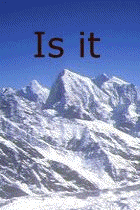GreehouseTruth Blog :: The latest fiery debate
The latest fiery debate
New study links wildfires to global warming
Posted July 8, 2006 by Nathan Cool
A story hit the news recently concerning a study published in the journal Science (here) that makes a direct correlation to increased wildfires and global warming.
This story flooded through the media with a vengeance with global warming proponents cheering "I told you so" while those in the every-thing-is-dandy camp got their feathers ruffled once again, including radical rightist, Rush Limbaugh (click here for Rush's comments). Once again, seemingly damning evidence of the consequences of human-induced climate change hit the headlines and airwaves, and as expected, some my-team mentality spewed forth from the global warming trenches. So what's really going on? Well, this topic, which I touched on throughout Is it Hot in Here, is no doubt a believable bellwether.
On one side of the fence, we have some skeptics arguing that forest fires are natural, which is true. We do need forests to burn; it's part of Mother Nature's recycling plan. Without occasional forest fires, dead biomass would pile up and provide copious amounts of fuel that could spark wildfires of immense proportions. Burning some woodland every now and then can be a good thing. But the operative vocabulary here is occasionally and every now and then.
The wildfires of recent times, as I mentioned in chapter 7 of Is it Hot in Here, have intensified. The new study that was published in the journal Science backs this up as well. Here are a few points regarding this new report to consider:
- Skeptics may argue that recent increases in forest fires are due to the land encroachment of the continually-growing human race and our exploding population moving constantly closer to forests. But, the new Science report states that the, "greatest increases [in wildfires] occurred in mid-elevation, Northern Rockies forests, where land-use histories have relatively little effect on fire risks, and are strongly associated with increased spring and summer temperatures and an earlier spring snowmelt."
- Hydrology (rainfall, water tables, etc.) in the U.S. is dominated by snow. Snow falls each winter, melts, fills streams, etc. But these snow packs also keep a nice wet blanket over much of the northern forests until spring. Once the snow melts, if things get warm, the melt water gets sucked out of the Earth, leaving the region now only snow-free, but often arid. Snowpacks are now melting one to four weeks earlier than they did 50 years ago, thus raising concern for the arid conditions in the U.S.'s vulnerable forests.
- warmer temperatures appear to be increasing the duration and intensity of the wildfire season in the western United States. Since 1986, longer, warmer summers have resulted in a fourfold increase of major wildfires and a sixfold increase in the area of forest burned, compared to the period from 1970 to 1986.
- So far this year (as of end of June 2006) wild fires swept across 3,123,689 acres in the U.S., more than four times that of last year's total for the same period, according to a recent report from CNN, here.
So is this real? You bet. Is it hype? The media love a good story, but this issue is serious, and deserves airtime. There are important implications with fire in a warming world, and how rangelands, forests, and your food supply could be affected, in more ways than you may realize.
To learn more, check out chapters 4, 6 and 7 in my latest book, Is it Hot in Here
